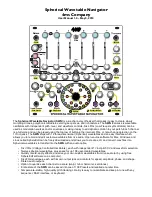
Editing the sound
19
Editing the sound
1. How a program is organized
Before you start editing, you’ll need to understand the basics of how the
sounds are created. Once you understand how the
microKORG XL+
’s
sounds are structured, you’ll be able to freely create the sounds you want.
Synthesizer
Timbre 1
Timbre 2
Synth
Synth
EQ
EQ
ARPEGGIATOR
MASTER FX2
MASTER FX1
Audio In
OUTPUT
(L/MONO, R)
OSC1
MIXER
FILTER1
FILTER2
DRIVE/WS
AMP
OSC2
NOISE
EG1
Keyboard Tracking
PAN
Keyboard Tracking
Velocity
Pitch Bend
Mod Wheel
Filter Routing= Individual
Drive/WS Position
= PreAmp
To EQ
Free Assign
OSC MOD
Synth
EG1
EG2
EG3
LFO1
LFO2
MIDI 1–3
VIRTUAL PATCH
Audio In
As shown in the illustration, a synth program consists of timbres 1/2, master
effects 1/2, and the arpeggiator.
The three elements of sound: pitch, tone, and volume
Sound has three basic elements: pitch, tone, and volume. Just like the ana-
log synthesizers of the past, the
microKORG XL+
analog modeling synthe-
sizer provides “oscillator,” “filter,” and “amp” (amplifier) sections that control
these three elements.
Edit the oscillator settings to change the pitch, the filter settings to change
the tone, and the amp settings to change the volume.
Oscillator, filter, and amp
On the
microKORG XL+
, the oscillator settings are found in the OSC1 and
OSC2 pages and the PITCH page. Use the PITCH page to specify the pitch
of the basic waveform, and then select the waveforms in the OSC1 and
OSC2 pages. The waveforms generated by this oscillator section are mixed
together by the mixer. The filter settings are located in the FILTER page. On
this page you can modify the tone by applying filters to the sound produced
by the oscillator.
Finally, the amp parameters are located in the AMP page. On this page you
can modify the volume.
You can create a basic program by editing the settings in these pages.
EG, LFO, keyboard tracking, virtual patch, and controllers
In addition to the way that it’s affected by the oscillator, filter, and amp, a
synthesizer sound can also change in various other ways; over the pas-
sage of time, according to the pitch you play, or in response to various per-
formance gestures. These changes in the sound are controlled by
modulators and controllers such as the EG (envelope generator), LFO (low
frequency oscillator), keyboard tracking, virtual patch, and wheels such as
[PITCH] and [MOD]. You can use these modulators and controllers to pro-
duce various changes in the basic sound of the program.
Take a look at the illustration that shows the structure of the
microKORG
XL+
. Notice that the signal flows in the order of OSC
FILTER
AMP.
You will also notice that these sections can be controlled by things such as
EGs and LFOs.
As shown in the illustration, a synth program consists of timbres 1/2,
effects, and the arpeggiator.
Timbres (TIMBRE 1/2)
Each timbre consists of an oscillator, filter, amp, EG, LFO, virtual patches,
and equalizer. The
microKORG XL+
has two timbres, and you can com-
bine these two timbres to create a richer-sounding program.
Editing the sound
















































